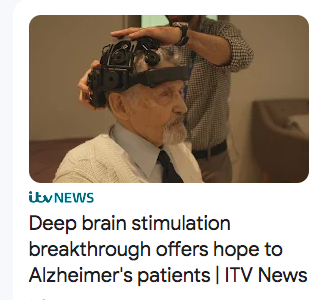New Hope in Alzheimer's Treatment: A Groundbreaking Discovery
Written on
Chapter 1: Understanding the Latest Developments
In the past few weeks, I've been engrossed in literature that highlights the importance of maintaining well-being in older age. It's essential to recognize that not every senior has the privilege of making informed health choices. Conditions like cancer, heart disease, arthritis, and dementia often severely affect countless lives. That's why I find it uplifting to stumble upon encouraging news stories, such as one I came across this morning.

Recent reports indicate that neuroscientists from the UK Dementia Research Group have achieved a remarkable advancement in treating Alzheimer’s patients through electrical stimulation rather than pharmaceuticals. This innovative method, termed temporal interference, employs electrodes affixed to the scalp to generate two non-intrusive electrical fields. When these fields intersect at a designated area in the brain, they produce an active field that prevents neurons from becoming excessively stimulated.
Section 1.1: How Temporal Interference Works
The hippocampus, a critical area of the brain associated with memory and learning, is significantly affected by Alzheimer’s disease, disrupting neuron communication within this region. Traditionally, to treat the hippocampus with electricity, surgical probes would need to be implanted deep within the temporal lobe. However, this new approach allows researchers to influence this area non-invasively, modifying its activity without the need for surgery.
Subsection 1.1.1: The Mechanism Behind the Breakthrough
The study introduces a novel form of deep brain stimulation, known as temporal interference (TI), which offers a non-surgical alternative for treating brain disorders, including Alzheimer’s. TI operates by delivering safely differing electrical frequencies via electrodes placed on the scalp and various head regions. The overlapping fields specifically target the hippocampus for stimulation, avoiding surrounding areas. The research has confirmed the technology's effectiveness in humans, demonstrating that TI stimulation during memory tasks enhances memory accuracy.

The intensity of the stimulation is comparable to holding a nine-volt battery in your hands—it's safe, and most participants report not feeling any sensation. Tests conducted on healthy brains indicated improvements in memory performance, and MRI scans have validated the safety and targeting capabilities of temporal interference. An initial pilot study is currently being conducted; for instance, 86-year-old Kenneth Bromwich is undertaking memory assessments while electrodes are strategically placed to deliver currents through his brain.
Section 1.2: The Impact of This Research
This groundbreaking discovery brings renewed hope to Alzheimer’s patients who have been awaiting a cure for many years. While pharmaceutical treatments are under development, no definitive cure currently exists for Alzheimer’s disease. Unfortunately, this research may arrive too late for many individuals living with this chronic condition or their caregivers. Nevertheless, the potential of this new treatment could signify a pivotal advancement in the ongoing battle against Alzheimer’s in the years to come.
Chapter 2: Exploring Further Insights
In the video titled "Breakthrough in Alzheimer's Disease Treatment," experts discuss the implications of this new research and its potential to transform treatment approaches.
Another enlightening video, "New drug brings hope to end Alzheimer's - BBC News," explores the ongoing developments in drug therapies alongside this non-invasive method.